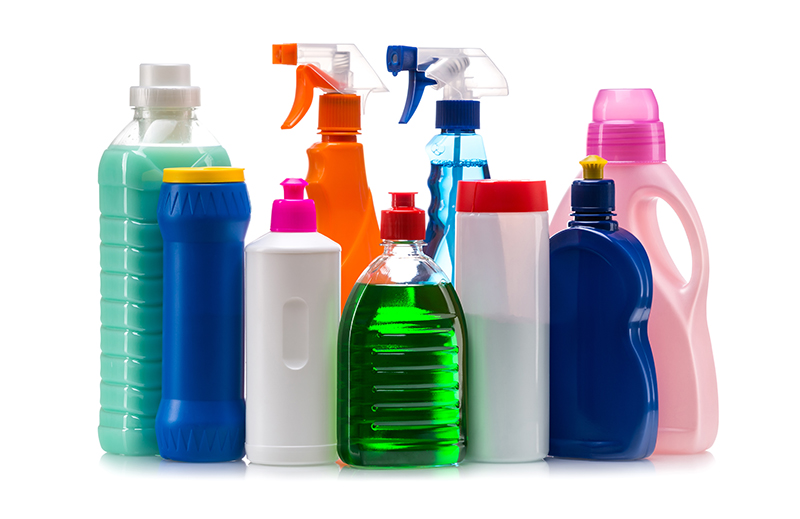A Lethal Dose
Addressing Our Global Chemical Toxicity Problem
Manufactured chemicals are everywhere, and their pervasive use is having a toxic effect not only on the planet but on our own bodies. It will take more than regulation and legislation to solve the problem.
Springtime has always offered the sounds, sights and smells of nature’s annual regeneration. But more than a half century ago, Rachel Carson sounded a warning. Nature’s spring renewal, she wrote, was at risk of being silenced by the overuse of synthetic chemicals, and by DDT in particular. Carson’s book, Silent Spring, became a beacon for global awareness of our environment. Her efforts were the catalyst for greatly restricting DDT in agriculture.
Despite her warnings, however, today’s broader and even more pervasive use of manufactured chemicals has largely met with a silence of its own. Yet their impact goes well beyond that described by Carson. Synthetic chemicals have now become embedded in all aspects of our lives. They show up in our food, personal care products, prescription drugs, household cleaners, toys, clothing, furniture and lawn-care products, to name but a few consumer applications.
What makes this especially troubling is that the testing process leading to a chemical’s approval for use is limited and inadequate. Many chemicals found in shampoos, detergents and other consumer products don’t even have to be tested before those products go on the market. The adverse effects are mounting to the point that toxicity is now considered one of the existential threats facing humankind. Julian Cribb, author of Surviving the 21st Century (2017), calls it “arguably the most under-rated, under-investigated and poorly understood of all the existential threats.”
“For the first time in Earth’s history a single species—ourselves—is poisoning the entire planet.”
The numbers are indeed staggering. The California Department of Toxic Substances Control reports that in the United States, more than 85,000 chemicals are now used in commerce, with 2,000 new chemicals introduced annually. Other sources indicate that global sales of chemicals have grown from US$171 billion in 1970 to US$5.2 trillion in 2016. Some estimate that chemicals are used in 96 percent of all manufactured goods. More than 98 percent of the US population register detectable levels of DEHP metabolites. DEHP, or Di-(2-ethylhexyl) phthalate, is a synthetic component of flexible plastics.
Chemicals found in human blood and tissue have been linked to infertility, immune system disorders, hyperactivity and developmental disorders. One study, published in the International Journal of Epidemiology, reports that more than 13 million deaths can be attributed to toxic agents annually, and that 24 percent of diseases are thought to result from such environmental chemical exposures. Synthetic chemicals are regularly detected in air, water and dust samples, with the majority of individuals in industrialized countries harboring a stew of toxic-substance residue in their blood and tissue.
How has the human body become such a repository of toxins? The pathway can be quite innocuous, with agricultural application and runoff representing just the tip of the iceberg. Take the example of flame retardants in upholstered furniture: every time you sit down, unseen particles of chemical-laden dust are released. That dust is then inhaled or ingested.
The US National Center for Biotechnology Information (NCBI) also cites the example of coal tar–based sealants on parking lots: “In apartment buildings adjacent to parking lots that are treated with these sealants, people are literally tracking this material into their homes, and it is resulting in higher levels of PAHs [polycyclic aromatic hydrocarbons] in the house dust in those homes.” PAHs are produced from burning or processing coal, oil, gasoline, wood, etc., and many are known carcinogens.
Growing Concerns
Emerging data can only deepen alarm regarding our ever-increasing exposure to toxic substances. For instance, until recently we didn’t fully understand that
- low doses of chemicals over time can have a significant effect;
- mixtures of chemicals can lead to unanticipated and compounded effects;
- exposure to chemicals during fetal and neonatal development can be especially harmful;
- exposure to chemicals can have an epigenetic effect; that is, they can influence heredity for multiple generations.
Let’s look at each of these growing concerns.
1) Low Doses
The standard assumption in the testing and regulation of chemicals has been that “the dose makes the poison.” Doses yielding results below toxic thresholds are deemed to pose no risk to the environment and are approved for use. But this approach is now being challenged. Low-dosage exposure continuing over time can in fact pose serious risks. Further, many chemicals of concern have never been examined at environmentally relevant doses.
Tyrone Hayes, professor of integrative biology at the University of California–Berkeley, has studied the effect of low-dose levels of atrazine on frogs. Atrazine is an herbicide widely applied to control weeds in crops such as corn, sugar cane and sorghum. The evidence shows that the accumulated impact of low-dose exposures has a dramatic effect on frog populations, particularly as it relates to hormone balance. Atrazine activates the enzyme aromatase, converting testosterone into estrogen; through chemical exposure, male frogs grow up and become female.
A major concern, of course, is that agricultural runoff affects other nontarget species as well. Researchers continue to study low-dose effects of endocrine-disrupting chemicals (EDCs), including atrazine, on humans. EDCs interfere with the body’s endocrine system and thus with the reproductive, neurological and immune systems as well.
Oncology research is also challenging long-held beliefs: it’s becoming apparent that exposure to small amounts of a carcinogen over a lifetime can be just as toxic as a few large doses.
2) Chemical mixtures
Toxicity testing has traditionally addressed chemicals acting independently. Very little research has focused on how toxicity may change when chemicals are combined, either in a product or after being released into the environment. The assumption has been that if a chemical is below a toxic level independently, it will remain so even when combined with other chemicals.
Studies now indicate, however, that chemical mixtures can intensify the effect of each constituent part. And chemicals not rated as poisonous in themselves can create a toxin when combined.
“Although more difficult than identifying single-source carcinogens, low-dose and mixed chemical exposures are no less a public health issue.”
3) Fetal and Neonatal Development
While exposure to toxic chemicals at any time of life can cause problems, it can be especially harmful during the fetal and neonatal period. The developing fetus and infant’s nervous and immune systems are highly vulnerable to toxins.
And those toxins are all around us. For example, DEHP, which is an EDC, is found in a variety of products that infants and toddlers may come in regular contact with: medical equipment, upholstery, food packaging, vinyl wall coverings and floor tiles, and dolls and other toys. DEHP can also cross the placenta and be absorbed by the fetus.
A 2016 review of recent studies into phthalate toxicity (including DEHP) concluded that “children are highly exposed to phthalates relative to adults”; these studies found children’s exposure to DEHP alone to range from “45 to 535 percent over the US EPA [Environmental Protection Agency] guideline value.” The review further noted, “Most studies agree that prenatal exposure to phthalates is linked with adverse health outcomes in newborns and children.”
Another endocrine disruptor is BPA (Bisphenol A), a high-production-volume chemical often used in the manufacture of polycarbonate plastic. BPA is also widely used in food packaging, including plastic beverage bottles and the lining inside food cans. A number of studies have concluded that because it mimics estrogen, BPA can affect reproductive development. Before being banned from use in baby bottles, it was leaching into milk or formula and was then ingested by the baby. Studies have suggested that the resulting altered hormone levels adversely affected system development and thus the future health of those exposed. BPA is also considered a weak carcinogen and may increase cancer risk in later life following in-utero or early childhood exposure.
But there’s more to this story. As the dangers of BPA became better known in recent years, some manufacturers responded by replacing it with alternatives such as BPS and marketing their products as “BPA-free.” Yet studies into these replacement chemicals now suggest that they may be just as harmful if not more so. Research published in the journal Fertility and Sterility goes so far as to declare that “bisphenol S and bisphenol F are not safe alternatives” to BPA, adding that “we should urgently focus on the human health risk assessment of BPA substitutes.”
“The manufactured world, it seems, is creating a chemical soup that is slowly polluting the ecosystem that is our body.”
4) Epigenetic Effects
From the developing field of epigenetics we’re learning that we’re creating heredity time bombs through the choices we make today. Epigenetics “holds that cellular or environmental conditions around the genes influence heredity and can lead to inherited effects (and disease) for multiple generations without changing the genes themselves” (“Beyond Lamarck: The Implications of Epigenetics for Environmental Law”). One of the triggers is chemical exposure, which can change the way a gene is expressed; the resulting altered traits can be passed on to offspring for two or more generations.
Long-term chemical exposure can build up a chemical residue in our cells, blood and tissue, which we will carry with us through life. Although more testing is needed, researchers now know that we can pass the residue of some of these chemicals on to our unborn progeny, in effect polluting our children.
As an example, a 2015 pilot study published in nature.com’s Scientific Reports found that the grandchildren of women who were exposed to lead while pregnant exhibited patterns of gene expression that implied direct lead exposure, even though no such exposure had occurred. Rather, the study’s authors suggested, these patterns—specifically in the epigenetic mechanism known as DNA methylation—had been inherited from the grandmother.
The issue of epigenetic impact on humans and animals has become one of the chief concerns of chemical regulatory agencies.
Conflicts and Interests
Given the abundance of data indicating an ever-growing threat from toxic contact and accumulation, why has the problem of chemical pollution proved so difficult to resolve?
For starters, the explosion of the manufacture and application of chemical products, coupled with weak testing criteria, has made it impossible for governments to keep pace with the expanding marketplace. Even if capacity and systems of oversight existed to test each new chemical, global standards as to what constitutes risk are lacking.
In the United States, even when toxicity is present, the chemical may be deemed safe under certain conditions. The US government will not ban a substance without conclusive evidence that exposure causes harm. Assessing exposure risks and biological outcomes in terms of causation can be difficult, however, as a variety of factors are at play. Age, stage of development, gender, genetics, nutrition, and the presence of other diseases or conditions can all affect outcomes.
Further, studies that find little or no risk to human health are in many cases funded by industry or by the chemical manufacturers themselves, fueling a debate over possible conflicts of interest and making the job of legislators that much more challenging. Lawmakers also face the unenviable task of weighing public health risks against the implications of limiting or banning chemicals that entire economic sectors (for example, agribusiness or manufacturing) have grown to depend on.
In contrast, European toxicologists apply the precautionary principle, which could be termed a better-safe-than-sorry approach. If there is a potential for risk, even absent conclusive proof, the chemical is typically not approved for use in the EU.

The scientific community itself is not in absolute agreement over the risks associated with low-dose exposure and chemical mixtures, so the debate continues. William Halperin, chair of the Department of Preventive Medicine at Rutgers New Jersey Medical School describes the current public health approach to assessing industrial chemicals as “the proverbial elephant examined by a group of blind men.” Each sees something different, depending on his specific “paradigm”: industrial hygiene, prevention, surveillance, etc.
No one is calling for the elimination of manufactured chemicals. Many are not only beneficial but save lives. The available data on toxicity and its detrimental effects on human health are troubling, however. Proposed solutions are varied and many, and can be distilled into three broad categories:
- Increase government testing and regulatory clout to adequately measure the risks of untested chemicals currently in the marketplace and of new chemicals before entering the marketplace, including risks pertaining to dosage and chemical mixtures.
- Allow private industry to self-regulate to ensure safety and health in the application and use of chemicals.
- Encourage corporate and private consumers to purchase only adequately tested and vetted chemicals, effectively forcing a shift in the chemical industry.
While each has strong advocates, none of these proposals has yet won global endorsement. The alarm has sounded, outcomes are becoming evident; we see an increasingly clear path of causation, but science, government and industry have to date failed to provide solutions.
The reason for such failure actually hits closer to home: the use of synthetic chemicals touches most aspects of Western life. As living standards increased, chemical pollution became the acceptable underside of progress; and when life is good, no one wants to disturb the status quo. Agricultural chemicals are an easy target, maybe because most of us live at arm’s length from the industries that provide our food. But when it comes to the products that fill our homes and make life convenient, despite the fact that they, too, are filled with toxins, we aren’t so quick to protest.
The reality is that legislation and regulation alone cannot solve the problem. The human will also comes into play—and there’s the rub. Scientific progress (in this case chemical development) without parallel ethical progress isn’t progress at all.
The Power to Change
In a 1958 letter to a friend, Rachel Carson explained her plans for a book about “Life and the relations of Life to the physical environment.” She admitted having struggled with some of the darker aspects of recent scientific progress: “It was pleasant to believe, for example, that much of Nature was forever beyond the tampering reach of man—he might level the forests and dam the streams, but the clouds and the rain and the wind were God’s. . . . It was comforting to suppose that the stream of life would flow on through time in whatever course that God had appointed for it—without interference by one of the drops of the stream—man. And to suppose that, however the physical environment might mold Life, that Life could never assume the power to change drastically—or even destroy—the physical world” (Always, Rachel).
But Life—at least, human life—has demonstrated “the power to change drastically” the course of both biological life and the environment supporting it.
“Only within the moment of time represented by the present century has one species—man—acquired significant power to alter the nature of his world.”
Carson continued her letter: “I still feel there is a case to be made for my old belief that as man approaches the ‘new heaven and the new earth’ [a reference to Revelation 21]—or the space-age universe, if you will, he must do so with humility rather than arrogance.”
Humility has not been a hallmark of humankind. Sixty years after Carson wrote those words, one of the results of our collective arrogance is the increasing toxic pollution of the planet as well as of our own bodies.
Humanity was charged with caring for the environment, both plant and animal life, and with treating one another with care and respect. But arrogance, vanity, greed, and the abandonment of an ethical and moral view of creation and the environment that supports life are pushing the planet to a state of decay, disease and degradation.
Solving our toxicity problems requires an ethical and moral component, which in turn would inform the efforts of government and science and industry. Such a change begins in the heart and will then be reflected in how we live life—with an outwardly focused concern for fellow man. That change includes a deep and humble respect for the environment and life about us. When the majority adopts that humble, concerned attitude, change will come.
Chemical Overload: What You Can Do
Each one of us can take steps to lower our own toxic load. The All That Matters information from the University of California–San Francisco’s Program on Reproductive Health and the Environment gives simple and doable practices that will not only help protect us and our families but provide some peace of mind in this increasingly turbulent world. Included are tips for home and office as well as on pesticide use and the food we eat.
A web search on the term “all-natural DIY cleaning products” yields a wealth of additional tips and recipes for making your own safe (and often less expensive) household cleaners.


